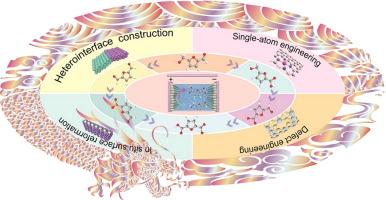5-hydroxymethylfurfural 电催化氧化的结构设计和机理启示
IF 13.1
1区 化学
Q1 Energy
引用次数: 0
摘要
生物质转化是缓解能源和环境问题的有效方法。最近几年,5-羟甲基糠醛(HMF)的电化学氧化因其温和的合成条件和高转化效率以获得 2,5-呋喃二羧酸(FDCA)而备受关注,但仍存在产率有限、循环寿命短和反应机理不明确等问题。尽管许多综述重点介绍了多种用于 HMF 电化学氧化的电催化剂,但仍缺乏对催化剂结构调控和催化机理的详细讨论。我们在本文中全面总结了 HMF 电化学氧化为 FDCA 的最新进展,尤其侧重于机理研究以及为调节结构和优化电催化剂性能而开发的先进策略,包括异质界面构建、缺陷工程、单原子工程和原位重构。此外,还阐述了用于机理和活性位点研究的实验表征技术和理论计算方法,并展望了 HMF 电化学氧化所面临的挑战和未来的发展方向。本综述将为设计先进的催化剂和加深对 HMF 电化学氧化为 FDCA 反应机理的理解提供指导。本文章由计算机程序翻译,如有差异,请以英文原文为准。

Structural designs and mechanism insights into electrocatalytic oxidation of 5-hydroxymethylfurfural
Biomass conversion offers an efficient approach to alleviate the energy and environmental issues. Electrochemical oxidation of 5-hydroxymethylfurfural (HMF) has attracted tremendous attention in the latest few years for the mild synthesis conditions and high conversion efficiency to obtain 2,5-furan dicarboxylic acid (FDCA), but there still remain problems such as limited yield, short cycle life, and ambiguous reaction mechanism. Despite many reviews highlighting a variety of electrocatalysts for electrochemical oxidation of HMF, a detailed discussion of the structural modulation of catalyst and the underlying catalytic mechanism is still lacking. We herein provide a comprehensive summary of the recent development of electrochemical oxidation of HMF to FDCA, particularly focusing on the mechanism studies as well as the advanced strategies developed to regulate the structure and optimize the performance of the electrocatalysts, including heterointerface construction, defect engineering, single-atom engineering, and in situ reconstruction. Experimental characterization techniques and theoretical calculation methods for mechanism and active site studies are elaborated, and challenges and future directions of electrochemical oxidation of HMF are also prospected. This review will provide guidance for designing advanced catalysts and deepening the understanding of the reaction mechanism beneath electrochemical oxidation of HMF to FDCA.
求助全文
通过发布文献求助,成功后即可免费获取论文全文。
去求助
来源期刊

Journal of Energy Chemistry
CHEMISTRY, APPLIED-CHEMISTRY, PHYSICAL
CiteScore
19.10
自引率
8.40%
发文量
3631
审稿时长
15 days
期刊介绍:
The Journal of Energy Chemistry, the official publication of Science Press and the Dalian Institute of Chemical Physics, Chinese Academy of Sciences, serves as a platform for reporting creative research and innovative applications in energy chemistry. It mainly reports on creative researches and innovative applications of chemical conversions of fossil energy, carbon dioxide, electrochemical energy and hydrogen energy, as well as the conversions of biomass and solar energy related with chemical issues to promote academic exchanges in the field of energy chemistry and to accelerate the exploration, research and development of energy science and technologies.
This journal focuses on original research papers covering various topics within energy chemistry worldwide, including:
Optimized utilization of fossil energy
Hydrogen energy
Conversion and storage of electrochemical energy
Capture, storage, and chemical conversion of carbon dioxide
Materials and nanotechnologies for energy conversion and storage
Chemistry in biomass conversion
Chemistry in the utilization of solar energy
 求助内容:
求助内容: 应助结果提醒方式:
应助结果提醒方式:


